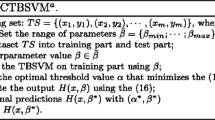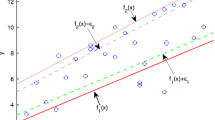Abstract
After combining the ν-Twin Support Vector Regression (ν-TWSVR) with the rough set theory, we propose an efficient Rough ν-Twin Support Vector Regression, called Rough ν-TWSVR for short. We construct a pair of optimization problems which are motivated by and mathematically derived from a related ν-TWSVR Rastogi et al. (Appl Intell 46(3):670–683 2017) and Rough ν-SVR Zhao et al. (Expert Syst Appl 36(6):9793–9798 2009). Rough ν-TWSVR not only utilizes more data information rather than the extreme data points in the ν-TWSVR, but also makes different points having different effects on the regressor depending on their positions. This method can implement the structural risk minimization and automatically control accuracies according to the structure of the data sets. In addition, the double ε s are utilized to construct the rough tube for upper(lower)-bound Rough ν-TWSVR instead of a single ε in the upper(lower)-bound ν-TWSVR. Moreover, This rough tube consisting of positive region, boundary region, and negative region yields the feasible set of the Rough ν-TWSVR larger than that of the ν-TWSVR, which makes the objective function of the Rough ν-TWSVR no more than that of ν-TWSVR. The Rough ν-TWSVR improves the generalization performance of the ν-TWSVR, especially for the data sets with outliers. Experimental results on toy examples and benchmark data sets confirm the validation and applicability of our proposed Rough ν-TWSVR.





Similar content being viewed by others
References
Cortes C, Vapnik V (1995) Support-vector networks. Mach Learn 20(3):273–297
Shen C, Wang X (2011) Analysis of convertible bond value based on integration of support vector machine and copula function. Commun Stat Simul Comput 40(10):1563–1575
Deka PC (2014) Support vector machine applications in the field of hydrology: a review. Appl Soft Comput 19:372–386
Flores MS, Verbraken T et al. (2015) Profit-based feature selection using support vector machines general framework and an application for customer retention. Appl Soft Comput 35:740–748
Schölkopf PB, Burgest C, Vapnik V (1995) Extracting support data for a given task. In: Proceedings of the first international conference on knowledge discovery and data mining. AAAI Press, Menlo Park, pp 252–257
Smola AJ, Schölkopf B (2004) A tutorial on support vector regression. Stat Comput 14(3):199–222
Schölkopf B, Bartlett P, Smola A et al. (1998) Support vector regression with automatic accuracy control, ICANN 98. Springer, London, pp 111–116
Vapnik V, Vapnik V (1998) Statistical learning theory. Wiley, New York
Deng N, Tian Y, Zhang C (2012) Support vector machines: optimization based theory, algorithms, and extensions. CRC Press, Boca Raton
Suykens JAK, Van Gestel T, De Brabanter J (2002) Least squares support vector machines. World Scientific
Mangasarian OL, Wild EW (2006) Multisurface proximal support vector machine classification via generalized eigenvalues. IEEE Trans Pattern Anal Mach Intell 28(1):69–74
Khemchandani R, Chandra S (2007) Twin support vector machines for pattern classification. IEEE Trans Pattern Anal Mach Intell 29(5):905–910. CampsLJ
Kumar MA, Gopal M (2009) Least squares twin support vector machines for pattern classification. Expert Syst Appl 36(4):7535–7543
Shao YH, Zhang C, Wang X, Deng NY (2011) Improvements on twin support vector machines. IEEE Trans Neural Netw 22(6):962–968
Peng X (2011) TPMSVM: A novel twin parametric-margin support vector machine for pattern recognition. Pattern Recogn 44(10):2678–2692
Peng X (2010) TSVR: An efficient twin support vector machine for regression. Neural Netw 23(3):365–372
Khemchandani R, Goyal K, Chandra S (2016) TWSVR: Regression via twin support vector machine. Neural Netw 74:14–21
Chen X, Yang J, Liang J et al. (2012) Smooth twin support vector regression. Neural Comput Appl 21 (3):505–513
Tanveer M, Shubham K, Aldhaifallah M, Nisar KS (2016) An efficient implicit regularized Lagrangian twin support vector regression. Appl Intell 44(4):831–848
Shao YH, Zhang C, Yang ZM, Jing L, Deng NY (2013) An ε-twin support vector machine for regression. Neural Comput Appl 23(1):175–185
Rastogi R, Anand P, Chandra S (2017) A ν-twin support vector machine based regression with automatic accuracy control. Appl Intell 46(3):670–683
Pawlak Z, Skowron A (2007) Rough sets and Boolean reasoning. Information rough 177(1):41–73. Sciences 177(2007) 21–73
Law Pawlak Z (2002) Rough sets and intelligent data analysis. Inf Sci 147(1):1–12
Chen RC, Cheng KF, Chen YH et al. (2009) Using rough set and support vector machine for network intrusion detection system. In: First Asian conference on intelligent information and database systems, ACIIDS 2009. IEEE, 465–470
Zhang J, Wang Y (2008) A rough margin based support vector machine. Inf Sci 178(9):2204–2214
Lingras P, Butz CJ (2010) Rough support vector regression. Eur J Oper Res 206(2):445–455
Zhao Y, Sun J (2009) Rough ν-support vector regression. Expert Syst Appl 36(6):9793–9798
Xu Y, Wang L, Zhong P (2012) A rough margin-based ν-twin support vector machine. Neural Comput Appl 21(6):1307–1317
Wang H, Zhou Z (2017) An improved rough margin-based ν-twin bounded support vector machine. Knowl-Based Syst 128:125–138
Xu Y, Yu J, Zhang Y (2014) KNN-Based weighted rough ν-twin support vector machine. Knowl-Based Syst 71:303–313
Karush W (2014) Minima of functions of several variables with inequalities as side conditions, Traces and Emergence of Nonlinear Programming. Springer Basel, pp 217–245
Blake CL UCI repository of machine learning databases. http://archive.ics.uci.edu/ml/index.php
Acknowledgements
The authors wish to acknowledge the financial support of the National Nature Science Foundation of China (No.61562001), The China Scholarship Council Foundation (No.201408410287), The National Social Science Foundation of China (No.13BGL063) and High level Scientific research cultivation Foundation of Henan University of Science and Technology (No.2015GJB010).
Author information
Authors and Affiliations
Corresponding author
Rights and permissions
About this article
Cite this article
Xue, Z., Zhang, R., Qin, C. et al. A rough ν-twin support vector regression machine. Appl Intell 48, 4023–4046 (2018). https://doi.org/10.1007/s10489-018-1185-3
Published:
Issue Date:
DOI: https://doi.org/10.1007/s10489-018-1185-3




